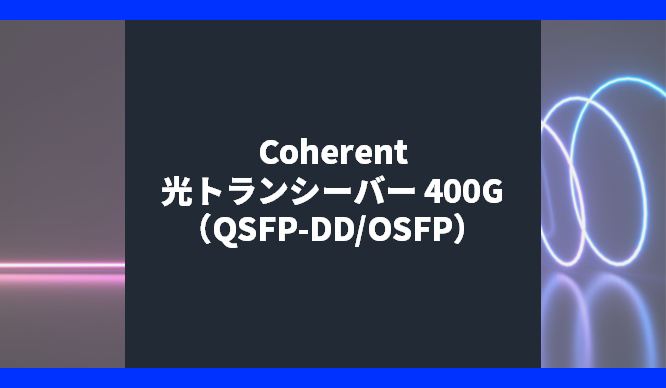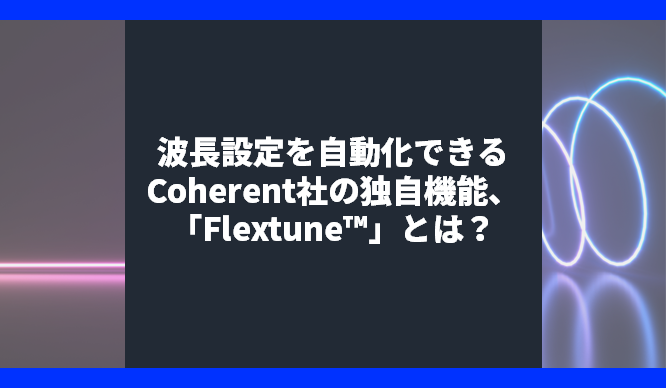Internet traffic is dramatically increasing due to the establishment of home working, connectivity to the cloud, the spread of generative AI, and the spread of new entertainment such as video streaming services. Transmission speeds are being upgraded to meet the demand for high-speed, broadband, and large-capacity networks, and 400G is being adopted and considered in backbone networks such as data centers and Internet connection providers.
Total download traffic for fixed broadband subscribers (estimated value) (cited from the aggregated results of internet traffic in Japan)
Therefore, this time we will take a deep dive into the standards (form factors) and optical transmission standards for 400G compatible optical transceiver modules. Please see the following link for the first part of the series, the 100G edition.
Transmission standards for optical transceiver modules ~100G edition~
Optical transceiver modules becoming faster and smaller
As introduced in the previous 100G article, there are various types of optical transceiver modules as they have responded to demands for faster transmission speeds and smaller size over time. See Table 1 below.
Table 1. Transmission speed and optical transceiver form factor
|
Transmission speed (Gbps) |
form factor |
|
1 |
SFP |
|
10 |
SFP+ |
|
25 |
SFP28 |
|
40 |
QSFP+ |
|
100 |
QSFP28 |
|
200 |
QSFP56 |
400G optical transceiver module form factor
QSFP-DD, which bundles 8 lanes of 50G to create 400G, has been standardized as a 400G optical transceiver module. DD stands for Double Density, which means it is double that of QSFP56, which has 50G with 4 lanes and has 200G. Note that QSFP-DD is backward compatible with QSFP28, so QSFP28 can be connected to the cage of QSFP-DD.
Later, OSFP was standardized. OSFP is larger than QSFP-DD and has advantages in terms of heat dissipation and internal circuit implementation. Subsequently, CFP8 was standardized, which bundles 25G signals on the electrical side into 16 lanes to make 400G. In recent years, QSFP112, which bundles 4 lanes of 100G signals to create 400G, has also been standardized.
Table 2. Form factors supporting 400G
|
form factor |
Speed and number of lanes per lane (electric side) |
|
QSFP-DD |
50G x 8 lanes |
|
OSFP |
|
|
CFP8 |
50G x 16 lanes |
|
QSFP112 |
100G x 4 lanes |
Currently, QSFP-DD and OSFP are the mainstream for 400G transceiver modules.
There are two types of OSFP: OSFP and OSFP-RHS (Riding Heat Sink). The difference between these is whether the optical transceiver module is equipped with a heat sink or not. Since OSFP is equipped with a heat sink, it can be connected to a cage that does not have a heat sink. On the other hand, OSFP-RHS does not have a heat sink, so it can be connected to a cage that has a heat sink.
Table 3. Cages that can be connected to OSFP/OSFP-RHS
|
form factor |
Cage without heat sink |
Cage with heat sink |
|
OSFP |
○ |
× |
|
OSFP-RHS |
× |
○ |
Figure 1 below shows the external dimensions of OSFP and OSFP-RHS as referenced from the OSFP MSA. You can imagine that the height of OSFP-RHS without a heat sink is low.
Figure 1. OSFP/OSFP-RHS shape (quoted from OSFP MSA Rev5.0)
400G optical transmission standard
Next, let's look at the transmission standards on the optical side. Table 4 below summarizes the 400G optical transmission standards.
Table 4. 400G optical transmission standards
|
Communication distance |
(C) Multicore optical fiber (MPO connector) |
(D) 2-core optical fiber (LC connector) |
|
|
(A)Multi-mode Fiber |
100m |
400GBASE-SR8 (IEEE P802.3cm) |
400GBASE-SR4.2 (IEEE P802.3cm) |
|
(B)Single-mode Fiber |
500m |
400GBASE-DR4 (IEEE P802.3bs) |
- |
|
2km |
400G DR4+ (100G Lambda MSA) |
400GBASE-FR4 (IEEE P802.3cu) |
|
|
10km |
4×100G LR4 (100G Lambda MSA) |
400G LR4-10 (100G Lambda MSA) |
|
|
120km |
- |
400G ZR (OIF 400ZR, amplified) |
|
|
1,000km |
- |
400G ZR+ (Open ZR+, amplified) *When optical fiber dispersion is 20ps/nm/km |
We will explain the classification in Table 4. First, the second line from the top (A) is the standard that uses Multi-mode fiber. Lines 3-7 (B) are standards that use Single-mode Fiber, and are classified by maximum communication distance. The third column from the left in Table 4 (C) is the standard that uses multi-core optical fiber. The fourth row (D) is a standard that uses two-core optical fiber.
The above standards are standardized by the following organizations:
・IEEE802.3 Ethernet Working Group of the Institute of Electrical and Electronics Engineers of America
・Multi Source Agreement (MSA) and other alliances between several optical transceiver module manufacturers
・An organization promoting optical network technology (OIF) in which optical network equipment and related component vendors participate.
Four representative standards based on transmission distance
Typical optical transmission standards for 400G optical transceiver modules include (1) SR8 for short distances, (2) (3) DR4/FR4 for medium distances, and (4) LR4-10 for long distances.
(1) 400GBASE-SR8 for short distance use
The 8 in SR8 indicates that the optical signal has 8 lanes. In other words, the optical signal consists of 50G x 8 lanes. Currently, the 400GBASE SR8 (Figure 2) is often used for short-distance connections with transmission distances of less than 100m.
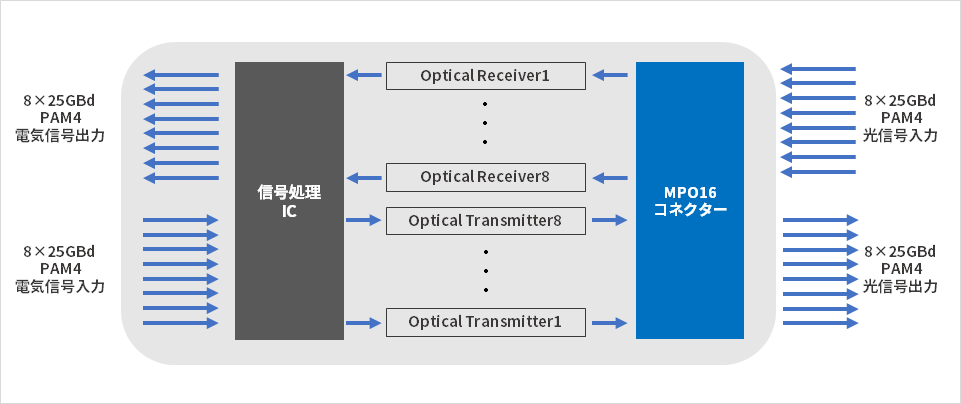
The signal modulation method uses PAM4 (Pulse Amplitude Modulation). NRZ transmits one bit with one symbol, so it is a binary signal transmission. On the other hand, PAM4 transmits 2 bits with one symbol, so it is a 4-level signal transmission. The actual waveforms of each are shown in Figure 3 below.

You can see that NRZ has two voltage levels (binary signal) and PAM4 has four voltage levels (quaternary signal). 400G communication improves transmission speed by using PAM4 as the modulation method.
(2)(3) 400GBASE-DR4 and 400GBASE-FR4 for medium distance use
Next, we will introduce the optical transmission standards 400GBASE-DR4, which has 4 lanes of optical signals and a transmission distance of up to 500m, and 400GBASE-FR4, which has a transmission distance of up to 2km.
The 4 in DR4 indicates that the optical signal has 4 lanes, resulting in a 100G x 4 lane configuration. However, if the form factor is QSFP-DD or OSFP, the electrical signal has a configuration of 50G x 8 lanes. Therefore, it is necessary to convert the transmission speed per lane, and a part called a gear Box is installed as a part to perform the conversion.
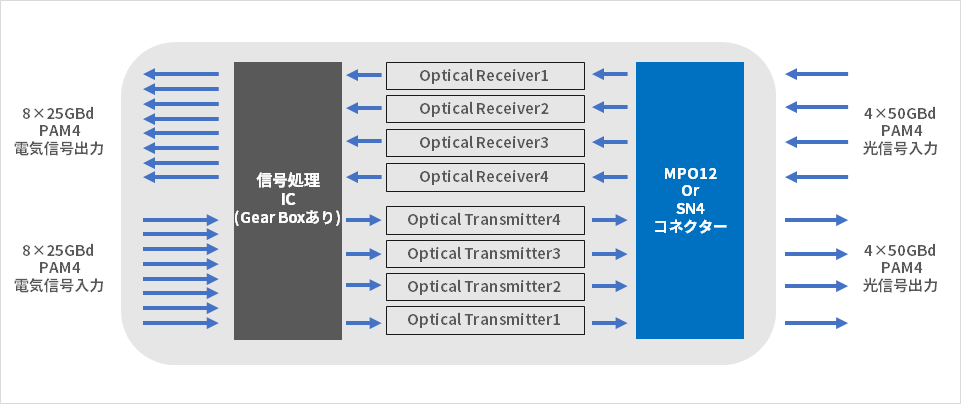
Breakout is also possible by using four optical transceivers with an optical transmission standard of 100GBASE-DR1, as shown in Figure 5 below.

Like DR4, FR4 has 4 lanes of optical signals, and has a configuration of 100G x 4 lanes. However, unlike DR4, it is transmitted using two optical fibers. DR4, whose transmission distance is within 500m, uses ribbon fiber, but FR4, whose transmission distance is within 2km, uses a technology called WDM (Wavelength Division Multiplexing) to multiplex four lanes of optical signals into one. It is sent through the book's optical fiber (Figure 6).
First, on the transmitting side, the optical wavelengths of the four lanes are shifted little by little, and an optical multiplexer (MUX) multiplexes the four optical signals, which are then transmitted over a single optical fiber. On the receiving side, on the other hand, a demultiplexer (DeMUX) separates the optical wavelengths so that each lane's signal can be received.
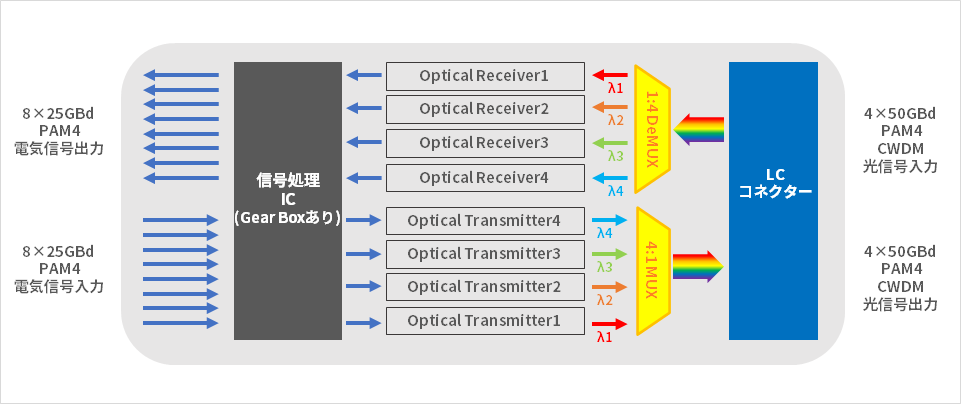
(4) 400G LR4(-10) for long distance use
400G LR4 is an optical transmission standard with a transmission distance of up to 10km. Like FR4, this LR4 has a 100G x 4 lane configuration and uses WDM technology.
Longer range 400G ZR/ZR+
ZR/ZR+ are transmission standards with longer transmission distances. ZR/ZR+ uses a modulation method called DP-16QAM, which is different from PAM4 mentioned above. For more information on this 400G ZR/ZR+, please check the technical article linked below.
bonus
If you want to reuse the optical fibers (connectors) that have already been installed when upgrading equipment from 100G to 400G, we have summarized the types of optical transmission standards that are backward compatible from 400G to 100G as follows.
Table 5. Equivalent 100G optical transmission standards and 400G optical transmission standards as backward compatible
|
Communication distance |
Multicore optical fiber (MPO connector) |
2-core optical fiber (LC connector) |
|
|
Multi-mode Fiber |
100m |
400GBASE-SR8 (IEEE P802.3cm) |
400GBASE-SR4.2 (IEEE P802.3cm) |
|
Single-mode Fiber |
500m |
400GBASE-DR4 (IEEE P802.3bs) |
- |
|
2km |
400G DR4+ (100G Lambda MSA) |
400GBASE-FR4 (IEEE P802.3cu) →Equivalent to 100G CWDM4 (CWDM4 MSA) |
|
|
10km |
4×100G LR (100G Lambda MSA) |
400G LR4-10 (100G Lambda MSA) →Equivalent to 100GBASE-LR4 (IEEE P802.3ba) |
|
|
120km |
- |
400G ZR (OIF 400ZR amplified) |
|
|
1,000km |
- |
400G ZR+ (Open ZR+ amplified) *When optical fiber dispersion is 20ps/nm/km |
Although the maximum transmission distance is the same for 100G and 400G, the optical transmission standards highlighted in green in Table 5 use different optical connectors, so there is currently no equivalent optical transmission standard for 100G.
On the other hand, the optical transmission standard 100G CWDM4 highlighted in red corresponds to 400GBASE-FR4. Also, for 100GBASE-LR4, 400G LR4-10 is equivalent. Therefore, if you are currently using 100G and are considering upgrading to 400G using optical fiber, etc., you will also need to check the optical transceiver module, etc.
We explained the transmission standards for 400G optical transceiver modules.
This article focused on the form factor and optical transmission standards of 400G-compatible optical transceiver modules. The 800G version will be released soon, so please take a look.
100G edition: https://www.macnica.co.jp/business/semiconductor/articles/coherent/144352/
Macnica offers the Finisar Transceiver series from Coherent, a leading company in optical transceiver modules. Our experienced sales staff and technical staff dedicated to optical transceiver module products provide comprehensive support from customer consideration to installation and operation. If you are interested, please contact us using the form below.



